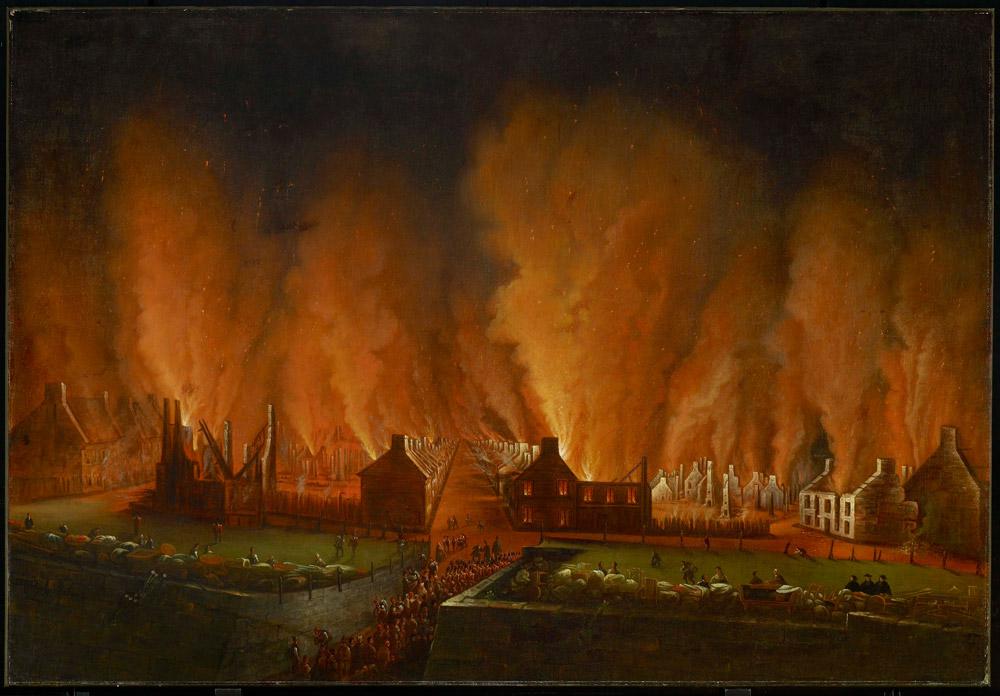The Fire in the Saint-Jean Quarter, Seen Looking Westward (1848) is both a stunning document of a devastating disaster and a profoundly engaging work of art. Joseph Légaré is a remarkable figure. Born in Quebec City in 1795, he was largely self-taught as a painter, honing his skills by making and selling copies of European religious paintings, salvaged from damaged churches following the French Revolution, that he purchased from a French priest. Légaré exhibited these and other works he acquired over the years in what he called the Galerie de peinture de Québec, Lower Canada’s first art museum. He was also Canada’s first native-born landscape painter, a practice he developed from the example of British topographical watercolourists in Quebec City, and from some European oils and prints in his collection. Légaré was deeply engaged in civic life: he was active in local politics, a justice of the peace for many years, and a member of several social and cultural organizations.
All of this came together in a group of amazing works he painted in response to two calamitous fires that struck Quebec City in 1845. Two large paintings depict the fire that destroyed the Saint-Roch quarter on May 28, levelling some 1,650 houses, killing about 20 people and leaving more than 12,000 homeless. Fire struck once more exactly one month later, devastating the adjacent and wealthier Saint-Jean quarter, where 1,302 houses were destroyed, and another 10,000 people were left without homes. Légaré again responded with a haunting painting of the smouldering ruins, but this time he also painted the conflagration at its peak, producing first a smaller version, and then a larger and in other ways more impressive canvas, which is the subject of our consideration here. His vantage point is above the old city ramparts near the Porte Saint-Jean, which afforded him an unobstructed view straight down rue Saint-Jean and through the centre of the blaze. The houses in this quarter were mainly built of stone, but their roofs and internal structures were all wood. Because it was essentially row housing, there was a point—which Légaré captured—at which the whole suburb was aflame.
We see that those who were able to grab belongings have piled them at the top of the grassy slope that rises up to the ramparts, as far from the flames as possible, where they stand guarding what they have saved. Others rush with a few possessions past hordes of citizens who stand behind a contingent of armed British soldiers in the narrow passageway to the city gate. Some of the houses are rubble, although one to the right—its roof gone but its stone walls still solid—suggests the possibility of rebuilding.
Pulling back from this detail to the billowing smoke, lit entirely by the soaring flames and accented by fiery sparks, we are drawn in and up. Légaré’s brushwork brilliantly supports this effect, and his almost primitive style of handling the details of people and buildings is in perfect balance. We pull back even farther, and the darkness at the base of the ramparts in the foreground connects with the intense black sky above the flames. Gradually, we sense that, as the flames subside, this darkness will swallow the whole scene.
This is an article from the Summer 2012 issue of Canadian Art. To read more from this issue, please visit its table of contents.

 Joseph Légaré The Fire in the Saint-Jean Quarter, Seen Looking Westward 1848 © Art Gallery of Ontario
Joseph Légaré The Fire in the Saint-Jean Quarter, Seen Looking Westward 1848 © Art Gallery of Ontario







